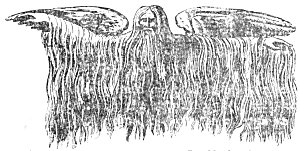The serpent was a familiar symbol in the Mysteries of Bakchos. The Initiates grasped them with their hands, as Orphiucus does on the celestial globe, and the Orpheo-telestes, or purifier of candidates did the same, crying, as Demosthenes taunted Æschines with doing in public at the head of the women whom his mother was to imitate, EVOI, SABOI, HYES ATTÊ, ATTÊ, HYES!
The Initiates in these Mysteries had preserved the ritual and ceremonies that accorded with the simplicity of the earliest ages, and the manners of the first men. The rules of Pythagoras were followed there. Like the Egyptians, who held wool unclean, they buried no Initiate in woolen garments. They abstained from bloody sacrifices; and lived on fruits or vegetables or inanimate things. They imitated the life of the contemplative Sects of the Orient; thus approximating to the tranquility of the first ashen, who lived exempt from trouble and crimes in the bosom of a profound peace. One of the most precious advantages promised by their initiation was, to put a man in communion with the Gods, by purifying his soul of all the passions that interfere with that enjoyment, and dim the rays of divine light that are communicated to every soul capable of receiving them, and that imitate their purity. One of the degrees of initiation was the state of inspiration to which the adepts were claimed to attain. The Initiates in the Mysteries of the Lamb, at Pepuza, in Phrygia, professed to be inspired, and prophesied; and it was claimed that the soul, by,
p. 421
means of these religious ceremonies, purified of all stain, could see the Gods in this life, and certainly, in all cases, after death.
The sacred gates of the Temple, where the ceremonies of initiation were performed, were opened but once in each year, and no stranger was ever allowed to enter it. Night threw her veil over these august Mysteries, which could be revealed to no one. There the sufferings of Bakchos were represented, who, like Osiris, died, descended to hell and rose to life again; and raw flesh was distributed to the Initiates, which each ate, in memory of the death of the Deity, torn in pieces by the Titans.
These Mysteries also were celebrated at the Vernal Equinox; and the emblem of generation, to express the active energy and generative power of the Divinity, was a principal symbol. The Initiates wore garlands and crowns of myrtle and laurel.
In these Mysteries, the aspirant was kept in terror and darkness to perform the three days and nights; and was then made Αφαυισμος, or ceremony representing the death of Bakchos, the same mythological personage with Osiris. This was effected by confining him in a close cell, that he might seriously reflect, in solitude and darkness, on the business he was engaged in: and his mind be prepared for the reception of the sublime and mysterious truths of primitive revelation and philosophy. This was a symbolic death; the deliverance from it, regeneration; after which he was called διφυης or twin-born. While confined in the cell, the pursuit of Typhon after the mangled body of Osiris, and the search of Rhea or Isis for the same, were enacted in his hearing; the initiated crying aloud the names of that Deity derived from the Sanscrit. Then it was announced that the body was found; and the aspirant was liberated amid shouts of joy and exultation.
Then he passed through a representation of Hell and Elysium. “Then,” said an ancient writer, “they are entertained with hymns and dances, with the sublime doctrines of sacred knowledge, and with wonderful and holy visions. And now become perfect and initiated, they are FREE, and no longer under restraint; but, crowned and triumphant, they walk up and down the regions of the blessed, converse with pure and holy men, and celebrate the sacred Mysteries at pleasure.” They were taught the nature and objects of the Mysteries, and the means of making themselves known, and received the name of Epopts; were fully instructed in the nature and attributes of the Divinity, and the doctrine of a
p. 422
future state; and made acquainted with the unity and attributes of the Grand Architect of the Universe, and the true meaning of the fables in regard to the Gods of Paganism: the great Truth being often proclaimed, that “Zeus is the primitive Source of all things; there is ONE God; ONE power, and ONE rule over all.” And after full explanation of the many symbols and emblems that surrounded them, they were dismissed with the barbarous words Κογξ and Ομπαξ, corruptions of the Sanscrit words, Kansha Aom Pakscha; meaning, object of our wishes, God, Silence, or Worship the Deity in Silence.

Moe is the founder of GnosticWarrior.com. He is a father, husband, author, martial arts black belt, and an expert in Gnosticism, the occult, and esotericism.





